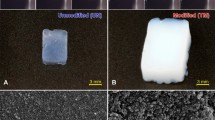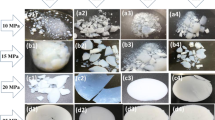Abstract
Silica aerogels are prepared by drying wet-gels under conditions that eliminate surface tension forces, typically by exchanging the pore-filling solvent with liquid or supercritical fluid (SCF) CO2 that is vented off like a gas. Thereby, silica wet-gels should not shrink during drying, but they do. According to the literature, most shrinkage (~71%) happens during depressurization of the autoclave. Here, based on prior literature, and working with wet-gels obtained via base-catalyzed gelation of tetramethylorthosilicate (TMOS), the basic hypothesis was that depressurization shrinkage takes place at the primary/secondary particle level. For this to happen there has to be available space to accommodate merging secondary particles, and a driving force. Secondary particles are mass fractals (by SAXS) and their empty space can accommodate primary particles from neighboring assemblies. The driving force was assumed to be H-bonding developing between surface silanols as soon as all fluids are removed from the pores. That hypothesis was put to test by replacing gelation solvents with nonhydrogen bonding toluene or xylene. Indeed, while the total drying shrinkage of toluene- or xylene-filled wet-gels was equal to that observed with aerogels obtained from acetone-filled wet-gels (~8–9%), the major part of that shrinkage (~74%) was transferred to the wet-gel stage. The remaining shrinkage (~26%) was assigned to interfacial tension forces between the pore-filling solvent and liquid or SCF CO2. Having transferred the major part of drying shrinkage to the wet-gel stage has technological implications, because it is easier to manipulate gels at that stage. Furthermore, our results underline that optimization of the drying process should take into account the fact that drying of silica wet-gels into aerogels is a two-stage moving boundary problem.

Highlights
-
The major part of the shrinkage during drying silica wet-gels to aerogels with SCF CO2 is associated with the depressurization phase of the drying process.
-
A part of the shrinkage equal to that reported as depressurization shrinkage (70–75%) has been transferred to the wet-gel phase of processing.
-
The remaining part of the drying shrinkage has been assigned to interfacial tension.
-
The practical significance of those findings is related to the fact that it is easier to control shrinkage at the wet-gel phase of processing.
-
From a theoretical perspective, drying with SCF CO2 is a two-stage moving boundary problem.














Similar content being viewed by others
References
Pierre AC, Pajonk GM (2012) Chem Rev 102:4243–4265
Kistler SS (1931) Nature 127:741–741
Smith DM, Scherer GW, Anderson JM (1995) J Non-Cryst Solids 188:191–206
Kirkbir F, Murata H, Meyers D, Chaudhuri SR (1998) J Non-Cryst Solids 225:14–18
Iswar S, Malfait WJ, Balog S, Winnefeld F, Lattuada M, Koebel MM (2017) Microporous Mesoporous Mater 241:293–302
Satha H, Atamnia K, Despetis F (2013) J Biomater Nanobiotechnol 4:17–21
Hæreid S, Nilsen E, Ranum V, Einarsrud MA (1997) J Sol-gel Sci Technol 8:153–157
Mohite DP, Larimore ZJ, Lu H, Mang JT, Sotiriou-Leventis C, Leventis N (2012) Chem Mater 24:3434–3448
Leventis N (2007) Acc Chem Res 40:874–884
Leventis N, Sotiriou-Leventis C, Zhang G, Rawashdeh A-MM (2002) Nano Lett 2:957–960
He F, Zhao H, Qu X, Zhang C, Qiu W (2009) J Mater Process Technol 209:1621–1626
Reichenauer G (2004) J Non-Cryst Solids 350:189–195
Mitsiuk BM, Vysotsky ZZ, Polyakov MV (1964) Dokl Akad Nauk SSSR 155:1404–1406
Stein DJ, Maskara A, Hæreid S, Anderson J, Smith DM (1994) In: Cheetham AK, Brinker CJ, Mecartney MA, Sanchez C (eds) Better Ceramics Through Chemistry VI. Materials Research Society: Pittsburgh, PA, p 643–648
Rao AV, Bhagat SD, Hirashima H, Pajonk GM (2006) J Colloid Inter Sci 300:279–285
Kanamori K, Aizawa M, Nakanishi K, Hanada T (2007) Adv Mater 19:1589–1593
Prakash SS, Brinker CJ, Hurd AJ, Rao SM (1995) Nature 374:439–443
Rangarajan B, Lira CT (1992) Mat Res Soc Symp Proc 271:559–566
Bohannan EW, Gao X, Gaston KR, Doss CD, Sotiriou-Leventis C, Leventis N (2002) J Sol-gel Sci Technol 23:235–245.
Mandal C, Donthula S, Soni R, Bertino M, Sotiriou-Leventis C, Leventis N (2019a) J Sol-gel Sci Technol 90:127–139
Mandal C, Donthula S, Majedi Far H, Saeed AM, Sotiriou-Leventis C, Leventis N (2019b) J Sol-gel Sci Technol 92:84–100
Snook IK, van Megan W (1981) J Chem Soc Faraday Trans 2 77:181–190
van Megan W, Snook IK (1979) J Chem Soc Faraday Trans 2 75:1095–1102
Ash SG, Everett DH, Radke C (1973) J Chem Soc Faraday Trans 2 69:1256–1277
Dahmouche K, Santilli CV, Chaker JA, Pulcinelli SH, Craievich AF (1999) J Appl Phys 38:172–175
Kawaguchi T, Hishikura H, Iura J (1988) J Non-Cryst Solids 100:220–225
Mohite DP, Mahadik-Khanolkar S, Luo H, Lu H, Sotiriou-Leventis C, Leventis N (2013) Soft Matter 9:1531–1539
Leventis N, Elder IA, Rolison DR, Anderson ML, Merzbacher CI (1999) Chem Mater 11:2837–2845
Rewatkar PM, Taghvaee T, Saeed AM, Donthula S, Mandal C, Chandrasekaran N, Leventis T, Shruthi TK, Sotiriou-Leventis C, Leventis N (2018) Chem Mater 30:1635–1647
Cabrera Y, Cabrera A, Larsen FH, Felby C (2016) Holzforschung 70:709–718
Ilavsky J, Jemian PR (2009) J Appl Cryst 42:347–353
Beaucage G (1995) J Appl Crystallogr 28:717–728
Beaucage G (1996) J Appl Crystallogr 29:134–146
Mang JT, Son SF, Hjelm RP, Peterson PD, Jorgensen BS (2007) J Mater Res 22:1907–1920
Agbabiaka A, Wiltfong M, Park C (2013) J Nanomater 640436, https://doi.org/10.1155/2013/640436
Potton JA, Daniell GJ, Rainford BD (1998) J Appl Cryst 21:891–897
Tatchev D, Kranold R (2004) J Appl Crystallogr 37:32–39
Winter HH (1987) Polym Eng Sci 27:1698–1702
Kim S-Y, Choi D-G, Yang S-M (2002) Korean J Chem Eng 19:190–196
Raghavan SR, Chen LA, McDowell C, Khan SA, Hwang R, White S (1996) Polymer 37:5869–5875
Muthukumar M (1989) Macromolecules 22:4656–4658
KjØniksen A-L, Nyström B, Lindman B (1998) Macromolecules 31:1852–1858
Borba A, Vareda JP, Durães L, Portugal A, Simões PN (2017) New J Chem 41:6742–6759
Brinker CJ, Scherer GW (1990) Sol-gel science: The physics and chemistry of sol-gel processing, Chap 3. Academic Press Inc, San Diego, CA, p 97–233
Graf C (2018) Silica, Amorphous in Kirk-Othmer Encyclopedia of Chemical Technology, 5th edn. John Wiley & Sons, New York, NY, p 7
Innocenzi P (2003) J Non-Cryst Solids 316:309–319
Bertoluzza A, Fagnano C, Morelli MA, Gottardi V, Guglielmi M (1982) J Non-Cryst Solids 48:117–128
Almeida RM, Pantano CG (1990) J Appl Phys 68:4225–4232
Chen J, Li T, Li X, Chou K, Hou X (2017) High Temp Mater Proc 36:607–613
McDonald RS (1958) J Am Chem Soc 62:1168–1178
Wu MK (1996) Aerosol Sci Technol 25:392–398
Pirard R, Blacher S, Brouers F, Pirard JP (1995) J Mater Res 10:2114–2119
Pfeifer P, Avnir D (1983) J Chem Phys 79:3558–3565
Celis R, Cornejo J, Hermosin MC (1996) Clay Min 31:355–363
Kobersein JT, Morra B, Stein RS (1980) J Appl Cryst 13:34–45
https://www.dataphysics-instruments.com/Downloads/Surface-Tensions-Energies.pdf Accessed 16 May 2019
http://www.ddbst.com/en/EED/PCP/SFT_C176.php Accessed 16 May 2019
http://www.ddbst.com/en/EED/PCP/SFT_C1050.php Accessed 16 May 2019
Majedi Far H, Rewatkar PM, Donthula S, Taghvaee T, Saeed AM, Sotiriou-Leventis C, Leventis N (2019) Macromol Chem Phys 220:1800333
Saeed AM, Rewatkar PM, Majedi Far H, Taghvaee T, Donthula S, Mandal C, Sotiriou-Leventis C, Leventis N (2017) ACS Appl Mater Interfaces 9:13520–13536
García-Gonzáleza CA, Camino-Reva MC, Alnaief M, Zetzl C, Smirnova I (2012) J Supercrit Fluids 66:297–306
Ozbakr Y, Erkey C (2015) J Supercrit Fluids 98:153–166
Lebedev AE, Katalevich AM, Menshutina NV (2015) J Supercrit Fluids 105:122–132
Karamanis G, Dinh H, Waisbord N, Hodes M (2018) In: Proceedings of the 16th International Heat Transfer Conference, IHTC16-24239, China National Convention Center, Beijing, China
Acknowledgements
We thank the NSF under award no. 1530603 for financial support. We also thank Prof. Marc Hodes of Tufts University for fruitful discussions and the Materials Research Center of the Missouri University of Science and Technology for support with materials characterization.
Author information
Authors and Affiliations
Corresponding authors
Ethics declarations
Conflict of interest
The authors declare that they have no conflict of interest.
Additional information
Publisher’s note Springer Nature remains neutral with regard to jurisdictional claims in published maps and institutional affiliations.
Supplementary information
Rights and permissions
About this article
Cite this article
Mandal, C., Donthula, S., Rewatkar, P.M. et al. Experimental deconvolution of depressurization from capillary shrinkage during drying of silica wet-gels with SCF CO2 why aerogels shrink?. J Sol-Gel Sci Technol 92, 662–680 (2019). https://doi.org/10.1007/s10971-019-05124-x
Received:
Accepted:
Published:
Issue Date:
DOI: https://doi.org/10.1007/s10971-019-05124-x




